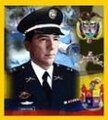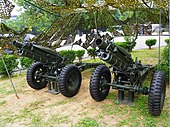National Army of Colombia
This article has multiple issues. Please help improve it or discuss these issues on the talk page. (Learn how and when to remove these messages)
|
| National Army of Colombia | |
|---|---|
| Ejercito Nacional de Colombia | |
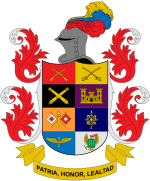 Coat of Arms of the National Army of Colombia | |
| Founded | 7 August 1819 (205 years, 2 months and 24 days) |
| Country | |
| Type | Standing army |
| Role | Land warfare |
| Size | 223,150 personnel[note 1] 25,050 reservists[note 2] |
| Part of | Military Forces of Colombia |
| Garrison/HQ | Comando del Ejército Bogota D.C., Colombia |
| Motto(s) | Patria, Honor, Lealtad "Homeland, Honor, Loyalty" |
| Colors | Red with Army Crest [2] |
| March | Himno del Ejército "Army Anthem" |
| Anniversaries | August 7 (Battle of Boyacá) |
| Engagements | Colombian Independence War Gran Colombia–Peru War Ecuadorian–Colombian War Thousand Days War Leticia Incident Korean War Colombian Armed Conflict |
| Website | www |
| Commanders | |
| Commander-in-Chief | President Iván Duque Márquez |
| Commander | Major General Nicasio de Jesus Martinez Espinel |
| Notable commanders | Simon Bolivar, Francisco de Paula Santander, Gustavo Rojas Pinilla, Harold Bedoya Pizarro, Manuel José Bonnet Rafael Reyes Prieto |
| Insignia | |
| Flag |  |
The National Army of Colombia (Spanish: Ejército Nacional de Colombia) is the land warfare service branch of the Military Forces of Colombia. With over 220,000 active personnel as of 2018, it is the largest and oldest service branch in Colombia, and the third largest army in the Americas after Brazil and the United States.
It is headed by the Commander of the National Army (Comandante del Ejército Nacional), falls under the authority of the General Commander of the Military Forces (Comandante General de las Fuerzas Militares), and is supervised by the Ministry of National Defense, which answers to the President of Colombia.[3]
The modern Colombian Army has its roots in the Army of the Commoners (Ejército de los Comuneros), which was formed on 7 August 1819 – before the establishment of the present day Colombia – to meet the demands of the Revolutionary War against the Spanish Empire. After their triumph against the Spanish, the Army of the Commoners disbanded, and the Congress of Angostura created the Gran Colombian Army to replace it. Throughout its history, the Colombian Army has seen action in several wars and civil conflicts, including the Gran Colombia-Peru War, the Ecuadorian–Colombian War, the Thousand Days War, and the Korean War. Since the mid-1960s, the Colombian Army has been involved in a low-intensity asymmetrical war known as the Colombian Armed Conflict.
Mission
The mission statement of the Colombian Army is to conduct military operations oriented towards defending the sovereignty, independence, and territorial integrity (of the nation), and protecting the civilian population, and private and state resources, to contribute in generating an environment of peace, security, and development, that guarantees the constitutional order of the nation.[4]
History

The Colombian Army traces its history back to the Army of the Commoners – the revolutionary army made up of peasants, llaneros, and other such militiamen during the days of the Colombian War of Independence.
Independence
On July 20 of 1810, Colombia declared its independence from the Spanish Empire, following a long period of political instability within the Spanish Crown due to the Peninsular War. With the Spanish driven out temporarily, a period of nationwide instability and conflict known as the Foolish Fatherland broke out from 1810 to 1816, between federalists and centralists, as many cities and provinces across the country set up their own autonomous juntas. Due to Colombia's challenged geography and the lack of communication between many provinces and cities, the juntas declared themselves sovereign from each other. This fragmentation prevented the proper establishment of a regular army, and it would take nine years before a truly national army would be formed. During this prolonged period of struggling consolidation, the Spanish Crown took advantage of the national disunity, and launched a military campaign in 1816, led by General Pablo Morillo to reassert the authority of the Spanish Empire over its previous holdings. The United Provinces of New Granada tried to resist with an army under the command of Antonio Baraya and Custodio García Rovira, but were defeated by the Spanish forces at the Battle of El Tambo[5] and the Battle of Bajo Palacé effectively reestablishing Spanish rule in New Granada.[6] With New Granada once again under control of the Spanish, Morillo launched a campaign of terror by executing many of the leaders of the independence movement – often in public squares – in order to instill fear. The Gran Colombian Army was consolidated on August 7, 1819, following the defeat of the Spaniards at the Battle of Boyacá under the command of Simon Bolivar.
19th Century and civil wars (1819–1903)
With independence gained after the defeat of the Spanish Royalist forces at the Battle of Boyacá in 1819, the republic of Gran Colombia was established by the Constitution of Cúcuta in 1821, with its capital in Bogotá. There upon the Gran Colombian Army was formed.
Gran Colombia – Peru war
In 1828 a war broke out with Peru and the Gran Colombian Army was called upon to defend the nation's sovereignty. The war lasted into 1829 with a Peruvian naval victory, but the Colombians were victorious on land with the crushing of the Peruvian invasion force at the Battle of Tarqui. The war ended in a stalemate.[7]
Civil wars (1830–1903)


After the dissolution in 1830 of Gran Colombia and the death of Bolivar, the Army of the new New Granada had been involved in war and civil war without being able to progress or modernize. Its officers were not well trained or technically skilled. The government addressed this by founding and organizing military schools and colleges, but was hampered by the constant civil wars that financially drained the country's economy. In 1839 General Tomas Cipriano de Mosquera hired Italian Colonel Agustin Códazzi as an inspector of the army. As a consequence of these civil wars over partisan affairs, the chiefs and officers began to be involved in politics. The need to professionalize and retrain the army prompted the creation of a military school, which was created in 1887. In order to reorganize the army, the government hired a French military mission. Its mission was fruitful and the organization along French lines based on divisions, regiments and battalions was implemented in the country. Unfortunately another civil war, perhaps the most devastating of them all, the Thousand Days War, was declared on October 8, 1899, and did not allow the retraining and education of officers and commanders. This civil war lasted until 1903. With the ending of the Thousand Days War, General Rafael Reyes Prieto was elected President of Colombia with many ambitious plans to reorganize and professionalize the army. The first thing he did was to reduce troop numbers drastically: the army at the time had an estimated 80,000 troops who were poorly equipped, poorly trained, poorly dressed and very malnourished. Also the army lacked professionalism and sense of duty to the country and never acted as a national army, acting instead as militias and armed factions led by Commanders who had their own political agendas.[8]
Military reform of 1907


In 1907 a military reform was carried out by President Rafael Reyes Prieto right in the aftermath of the Thousand Days War which had devastated the country economically and morally. The ministry of war hired a Chilean military mission to advise the ministry on how to professionalize the army. This led to the creation of the Colombian Military School in June 1907. The Army was then dramatically reorganized under the guise of the Chilean military mission, the Chilean army which had adopted Prussian military doctrine and uniforms since 1886 did the same to the Colombian army as Colombian troops began using Prussian military uniforms and doctrine, which is still present today in the Colombian Military Academy with ceremonial uniforms being of Prussian influence and the use of Pickelhaube helmets.[9] The Chileans reorganized the Colombian Army into Divisions made up of a divisional HQ, 3 Infantry regiments,1 Artillery regiment, and 1 Cavalry regiment each, meanwhile, military engineers were grouped with the Infantry regiments. This military reform allowed the Colombian army to become professionalized and a truly National army was established. The army remained under the influence of the Chilean military mission until the mission left in 1914.[10] Colombia remained neutral during World War 1 but did watch how the conflict progressed and sent military attachés to Europe after the war to study new technological advancements in aviation, infantry, cavalry, engineering and training methods.
The Leticia Incident and the 1930s
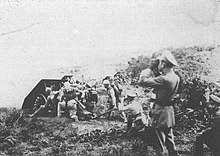
In 1926 the Colombian Government hired another military mission, this time from Switzerland, to reorganize the army again. As a result of this new combined brigades were implemented.[11]
In late 1932 an armed band of Peruvian civilians and soldiers (supposedly acting without Peruvian government approval) took the Amazonian town of Leticia and forced the Colombian residents to flee. The Peruvian President tried to disassociate himself from these actions, but popular opinion quickly forced him to support the seizure of Leticia. The Colombian government responded forcefully, sending an expeditionary force which defeated the Peruvians and retook Leticia. The war led to an explosion of Colombian patriotism.[12] In the Battle of Güepí 1000 Colombian troops attacked 200 entrenched Peruvian troops and took control of the sector with the Peruvians abandoning their positions.[13]
The League of Nations was asked to mediate with the support of Brazilian diplomats, and eventually oversaw the peaceful return of the area to Colombian control. The process generated an interesting historical precedent: for the first time ever, soldiers wore the armband of an international organization (the League of Nations) as they performed peacekeeping duties. The soldiers were Colombian, and the use of the League armbands was primarily a face-saving device to permit the Peruvians to leave without appearing to submit to the Colombians. Nevertheless, the use of these 75 Colombian soldiers as international peacekeepers was an antecedent of United Nations peacekeeping several decades later.
During the latter part of the 1930s, Colombia began buying more German war material and the German Stahlhelm helmet became the standard issue helmet for all Colombian troops until the 1950s.[14]
1940s–1950s
On the outbreak of Second World War in September 1939, Colombia, in accordance with its international policy, declared itself a belligerent, as did many other Latin American countries, and received arms and equipment from the United States as part of the Lend Lease program. The first American military missions arrived in the country, and Colombian officials were sent to the United States to perfect their knowledge; as a result of these links a new doctrine[clarification needed] was adopted in the military forces. After the war, the army continued to receive assistance from American missions, and officers attended courses in the United States. Political changes in the country starting in 1946 led up to the civil war known as la Violencia, which started with the El Bogotazo riots of April 9, 1948. The army then became involved in the restoration of public order.[15]
Recent history
This section needs additional citations for verification. (November 2016) |
The Colombian Army is presently at war with leftist rebels of the FARC, ELN and EPL, as well as other minor groups. Members of the military have been accused or condemned of collaborating with the activities of right-wing paramilitaries, such as the AUC and others. The BBC and other sources have reported on cases of corruption within the military, as well as other scandals.[citation needed] However, the army has taken measures to become a transparent and professional fighting force.[citation needed]
Plan Colombia and modernization
The United States government approved the Plan Colombia initiative in the late 1990s. Part of the resources provided by this initiative would be directed to the support of the Colombian Army by strengthening its combat and logistics capabilities. This Plan greatly benefited the Colombian Army. During the 1990s with the guerrillas gaining more money than ever due to controlling large portions of the drug trade, the FARC began changing their tactics and went from guerrilla warfare to a war of large movements and large attacks where large numbers of guerrillas would combine their forces to capture towns and cities. With the aid received from Plan Colombia, then commander of the armed forces General Fernando Tapias led an internal purification in the army that had the support of the other force commanders and the government. This process contributed to improving substantially the problematic relationship the country had previously had with the United States. This was the beginning of the modernization of the army: Colombian soldiers began receiving the training and technology to confront the guerrillas head-on. With the buying of American Black Hawk helicopters, they learned to deploy quickly into rugged guerrilla terrain. Technical equipment was improved drastically with the US providing satellite-guided bomb “kits” to the Colombian army which also made the Colombian army the first military force in South America to utilize these "smart bombs". With the aid of these bombs the army killed more than two dozen FARC commanders, including Mono Jojoy. With training improved and better equipment the Colombian people now have high regards for the army and internationally they are widely viewed as Latin America’s best-prepared and most professional army.[16]
Operation Jaque

The Colombian Army carried out Operation Jaque, a military operation that resulted in the rescue of 15 hostages, including former Colombian presidential candidate Íngrid Betancourt. The hostages had been held by the FARC. The operation took place on July 2, 2008, along the Apaporis River in Guaviare Department. It was unprecedented in the army's history, in that the intelligence gathering for the operation involved the army placing a mole within the FARC itself for one year or more before the operation. The plan involved tricking FARC rebels into handing over the hostages by having Colombian soldiers pose as members of a fictitious non-government organisation that supposedly would fly the captives to a camp to meet rebel leader Alfonso Cano. Several aspects of the mission were apparently designed to mimic previous Venezuelan hostage transfers, including the actual composition of the group and the type and markings of the helicopters used. Two Mi-17 helicopters came to the landing area in Guaviare, where one, carrying Colombian agents wearing Che Guevara T-shirts, landed to pick up the hostages. The hostages were handcuffed and loaded aboard, and the local FARC commander César and an additional rebel also boarded the helicopters. They were then subdued by Colombian forces. Betancourt realised she was being rescued only when she saw her captor naked and blindfolded on the floor of the aircraft.[18]
Lancero Course
One of the more demanding courses run by the Colombian Army is the Lancero School. This course – dedicated to counterinsurgency warfare – is held in Tolemaida, 150 miles (240 km) from Bogotá, where temperatures range between 85 and 100 degrees F. (29.5–38 degrees C.) throughout the year, with U.S. military instructors also playing a role. The course lasts 73 days and trains Bolivian, Ecuadorean, and Panamanian troops as well as Colombian soldiers; some French and American soldiers are also trained there.[19] The course, founded in 1955, was based on the methodology of the United States Army Ranger School. Lethal techniques and live ammunition are used.
Overseas military operations
Korean War

During the Korean War, some 4,314 troops of the Colombian Army (21% of the total force) served in the Colombian Battalion in the United Nations Command. The initial contingent of troops transported to Korea aboard the USNS Aiken Victory. Once in-country, the Colombian Battalion received training and then joined the American 21st Infantry Regiment on 1 August 1951. It was engaged in battle during Operation Nomadic, for which the battalion received a Presidential Unit Citation. In 1952, as the 21st Infantry Regiment redeployed, the Colombian Battalion was transferred to the 31st Infantry Regiment. The battalion was greatly involved in the Battle of Old Baldy. Colombian soldiers killed in action were sometimes cremated at the United Nations Cemetery in Tanggok and repatriated in 1954.[20] Four different Colombian battalions rotated to Korea. Overall, the Colombian Army lost 141 soldiers by death and suffered 556 battle injuries.[21]

Sinai
The Colombian National Army deployed soldiers in the Sinai as part of the United Nations Emergency Force following the Suez Crisis in and until the Six-Day War in 1967.[22] Since 1980 it has supplied one battalion ('COLBATT') to the Multinational Force and Observers there.
Organization

Major units
Divisions
Colombian Army Divisions are static Regional Commands
- 1st Division (Santa Marta) – Its jurisdiction covers the Northern Region of Colombia in which there are the departments of Cesar, La Guajira, Magdalena, Sucre, Bolívar and Atlántico. 2nd Mechanized and 10th Armored brigades.
- 2nd Division (Bucaramanga) – Its jurisdiction covers the north eastern Colombia in which there are the departments of Norte de Santander, Santander and Arauca. 5th Infantry, 30th Infantry and 23rd Mobile brigades.
- 3rd Division (Cali) – Its jurisdiction covers the South West of Colombia in which there are the Departments of Nariño, Valle del Cauca, Cauca, Caldas, Quindio, Risaralda and the southern part of the Chocó. 3rd, 8th, 23rd and 29th Infantry brigades.
- 4th Division (Villavicencio) – Its jurisdiction covers the eastern region of Colombia in which there are the departments of Meta, Guaviare, and part of Vaupés. 7th Infantry, 22nd Infantry and 31st Jungle Infantry brigades.
- 5th Division (Bogota) – Its jurisdiction covers the Central Region of Colombia in which there are the departments of Cundinamarca, Boyaca, Huila and Tolima. 1st Infantry, 6th Infantry, 8th Mobile, 9th Infantry and 13th Infantry brigades.
- 6th Division (Florencia) – Its jurisdiction covers the southern region of Colombia in which there are the departments of Amazonas, Caquetá, Putumayo and southern Vaupés. 12th Infantry, 13th Mobile, 26th Jungle and 27th Jungle brigades.
- 7th Division (Medellin) – Its jurisdiction covers the western region of Colombia in which there are the departments of Cordoba, Antioquia, and part of the Chocó. 4th, 11th, 14th, 15th and 17th Infantry and 11th Mobile Brigades
- 8th Division (Yopal) – Its jurisdiction covers the northeastern region of Colombia: the Departments of Casanare, Arauca, Vichada, Guainía, and the municipalities of Boyaca of Cubará, Pisba, Paya, Labranzagrande and Pajarito. 16th, 18th, 28th, and the 5th Mobile Brigade.
Other units
- Mobile Medical Command with 3 Battalions
- Military Education and Training Command
- 19th Cadet Brigade with 3 battalions
- Army Aviation with 135 helicopters and aircraft.
- Army Special Forces Division
Combat arms
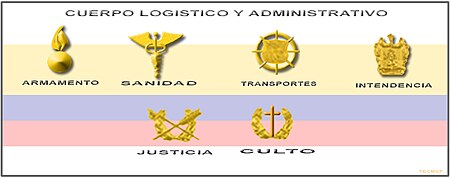
- Infantry (Infantería)
- Cavalry (Caballería)
- Artillery (Artillería)
- Engineers (Ingenieros)
- Intelligence (Inteligencia)
- Communications (Comunicaciones)
- Logistics and Administrative Corps (Cuerpo Logístico y Administrativo)
- Aviation (Aviación)
Special units
The Colombian Army has created new programs in order to fight terrorist guerrillas that during the last 40 years have fought a war to overthrow the Colombian government. They are highly trained, specially selected Colombian Army soldiers. They do special recon operations to find and expel Colombian terrorist hideouts.
Rapid Deployment Force
The Rapid Deployment Force or Fuerza de Despliegue Rápido abr. FUDRA, was created in 1999 as a modern quick reaction force to deploy to different regions and to all types of weather. Currently, its function is to solely carry out offensive operations against insurgents or outlaws.[23] It is an elite unit in the army and was one of the key factors that led to FARC losing much of its military power. Its greatest accomplishment was on the 23rd September 2010 when Operation Sodoma was executed and led to the death of the FARC's top military commander Jorge Briceño Suárez aka Mono Jojoy.[24]
Anti-Narcotics Brigade
- Anti-Narcotics Brigade (Brigada Anti-Narcoticos). This unit was specifically activated for operations against the trafficking of narcotics. It was created on December 8, 2000 and has its main headquarters in the Guaviare Department.
Air Assault Aviation Division
The Colombian National Army Aviation or División de Aviación Asalto Aéreo del Ejército, is an aviation branch that works autonomously from the Colombian Air Force. It is part of the Colombian Army and its main mission is to support the army's ground operations. This Unit was created on September 7, 2016 and it is managed by the Colombian Army.[25] Over the years the Army Aviation has grown tremendously as it has become and fundamental part of the defense of the nation's borders and sovereignty.[26]
AFEUR unit
The Urban Counter-Terrorism Special Forces Group, otherwise known as AFEUR (Spanish: Agrupación de Fuerzas Especiales Antiterroristas Urbanas) is an elite special operations unit within the Colombian Army, dedicated to performing counter-terrorism operations, HVT (High-Value Target) acquisition or elimination, and hostage rescues.
The unit is also used for protection of VIPs. For example, they protect the Colombian President when he travels, and provided protection for President Bill Clinton and President George W. Bush when they visited Cartagena, in 2000 and 2004, respectively. They also provided the second security ring to President Bush's visit to Bogotá in 2007.
AFEUR answers directly to the General Command of the Armed Forces (Comando General de las Fuerzas Armadas), and they are allowed to use any military air transportation to guarantee mobility, and to use any weapon or additional equipment as required to accomplish their missions.
AFEUR won the Fuerzas Comando 2005 contest, that took place in Chile in June 2005 lasting two weeks.
This yearly contest sponsored by the US South Command and the US Special Operations Command with similar teams from Argentina, Bolivia, Chile, Costa Rica, Ecuador, El Salvador, U.S., Guatemala, Honduras, Jamaica, Nicaragua, Panama, Paraguay, Dominican Republic, Peru and Uruguay.
AFEUR also won the 2006 and 2007 versions of this contest.
Special Forces Brigade
- Colombian National Army Special Forces Division
- Urban Special Forces Battalion[27]
GAULA groups

GAULA is an acronym for Grupos de Acción Unificada por la Libertad Personal, i.e. Unified Action Groups for Personal Liberty, specialising in solving hostage-taking. These are elite units established in 1996 exclusively dedicated to the combating of kidnapping and extortion. They are composed of highly qualified personnel who conduct hostage rescues and dismantling of criminal gangs at the root of crimes which compromise the personal freedom of Colombians. There is an inter-institutional element in GAULA guaranteeing self-checking procedures, trained by staff of the Administrative Security Department, the Technical Investigation Corps (CTI) of the Criminal Investigation Bureau (Fiscalía) and military forces. Currently, the country has 16 GAULA of the Colombian National Army and 2 of the Navy.
Presidential Guard

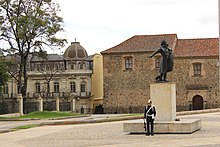
The Presidential Guard Battalion also known as 37th Infantry Presidential Guard Battalion is a unit of the Colombian Army and honor guard to the President of Colombia and the security detail for the President and his family in his official residence the Nariño Palace. The Battalion is made up of 9 companies, 4 of the companies represent the four traditional combat arms of the Colombian Army: Córdoba Company (Infantry), Rondon Troop (Cavalry), Ricaurte Battery (Artillery) and Caldas Company (Engineers).
The battalion had its origins in Simón Bolívar's Honor Guard, when he returned to Bogotá in 1814 he stayed in the San Carlos palace and was accompanied by his Honor Guard, which was distinguished from the other Units of the Bolívar's Patriot Army by the uniform that they wore, designed by Bolívar himself. On September 25 the commander of Bolívar's honor guard, Colonel Guillermo Fergusson an Irishman, sacrificed his life to save Simón Bolívar from an assassination attempt, in honor of his noble sacrifice the Presidential Guard Band and Corps of Drums which is its own company (the Fergusson Band) was named after him in his honor. The Battalion was re-established in 1927 by President Miguel Abadía Méndez, In 1948 during the infamous el Bogotazo a citywide street riot that almost destroyed all of the city center after infuriated supporters of liberal candidate for the presidency Jorge Eliecer Gaitán heard about his assassination that same day. The Presidential Guard was called up to protect the life of President Mariano Ospina Pérez and the lives of the members who were attending the 9th Pan-American Conference. When the infuriated crowds tried to take the Presidential Palace, the Battalion was able to defend it successfully, on that day Lieutenant Ruiz died on the steps of the palace entrance tying to defend it from the angry mobs.
The Battalion uses 2 dress uniforms, the honor guard wears a 19th-century uniform that was used by Simón Bolívar's Honor Guard, the color of this uniform is red and the uniform has 33 gold buttons, 11 buttons on each side. The 33 gold buttons represent the 33 battles that Bolívar fought in during his campaigns for South American Independence from Spain and, the 22 cords represent the 22 years that Bolívar had spent for fighting for independence. The second uniform is based on 20th century Prussian military uniforms, it is black and the Pickelhaube helmet is worn, the Presidential Guard band and Corps of Drums also uses this uniform.[28]
The Ricaurte Battery serves as the unit conducting 21-gun salutes during state visits and the Presidential inauguration.
Schools and courses
Courses
- Arms and Services Capacitation and Specialization Courses
- Military Professorate
- Sports and Professional Achievements
- Combat Specialization Courses:
- Lancero School
- Counter-Guerrilla Course
- Military Airborne School
- Special Forces Course
- Meritorious Conduct in Special Units Course
- Intelligence School
- Special Land Commandos Course
- Urban Commando Course
- Urban Counter-Guerrilla Course
- Psychological Operations Course
- Military Police Course
Military educational institutions
- Colombian Military Academy "General José María Córdova"
- Colombian Army NCO School "Sergeant Inocencio Chinca"
- Army Arms and Services School
- Army Infantry School
- Army Cavalry School
- Army Artillery School
- Military Engineering School
- Army Communications School
- Army Logistics School
- Colombian Army Military Police School
- School of Civil-Military Relations
- Army Equestrian School
- Army Aviation School
- Army International Missions Support School
- Army Human Rights and International Rights School
- Army School of Languages
Personnel
Rank and insignia
The rank structure for closely parallels that of the United States military. There are nine officer ranks, ranging from the equivalent of second lieutenant to general. The army has nine enlisted grades, ranging from the equivalent of basic private to command sergeant major
The tables below display the rank structures and rank insignias for the Colombian Army personnel.[29][30][n 1]
Officers
| Rank group | General / flag officers | Senior officers | Junior officers | |||||||||||||||||||||
|---|---|---|---|---|---|---|---|---|---|---|---|---|---|---|---|---|---|---|---|---|---|---|---|---|

|

|

|

|

|

|

|

|

| ||||||||||||||||
| General de ejercito | Mayor general | Brigadier general | Coronel | Teniente coronel | Mayor | Capitán | Teniente | Subteniente | ||||||||||||||||
| Abbr. | - | GR | - | MG | BG | CR | TC | MY | CT | TE | ST | |||||||||||||
Enlisted
| Rank group | Senior NCOs | Junior NCOs | Enlisted | |||||||||||||||||||||||||||||||||
|---|---|---|---|---|---|---|---|---|---|---|---|---|---|---|---|---|---|---|---|---|---|---|---|---|---|---|---|---|---|---|---|---|---|---|---|---|

|

|

|

|

|

|

|

|

|

| |||||||||||||||||||||||||||
| Sargento mayor de comando conjunto | Sargento mayor de ejército | Sargento mayor de comando | Sargento mayor | Sargento primero | Sargento vice primero | Sargento segundo | Cabo primero | Cabo segundo | Cabo tercero | |||||||||||||||||||||||||||
| Abbr. | SMCC | SME | SMC | SM | SP | SV | SS | CP | CS | C3 | DG | SLP | SL | |||||||||||||||||||||||
| English title | Joint Command Sergeant Major | Army Sergeant Major | Command Sergeant Major | Sergeant Major | First Sergeant | Sergeant First Class | Second Sergeant | First Corporal | Second Corporal | Third Corporal | Private First Class | Private (Professional) | Private Basic | |||||||||||||||||||||||
Uniforms
-
Historic uniform on LT Gómez Paris
-
Image of modern camouflage currently worn by the Colombian army.
-
Camouflage for desert operations.
-
Special Forces wearing the new field uniform
Colombian military personnel wore a number of different uniforms for both cold and hot weather. Army officer uniforms included a full-dress uniform of blue coat and white trousers for a cold climate; a white full-dress uniform for a hot climate; several different dress uniforms for both hot and cold climates that consisted of some combination of blue and white coat and trousers with piping or fringe on the trousers to indicate branch of service; an olive-drab barracks uniform for a cold climate; a tan gabardine barracks uniform for a hot climate; and tan gabardine service and field uniforms for all climates. Army enlisted uniforms consisted of an olive-drab dress uniform for a cold climate, a tan flannel dress uniform for a hot climate, and tan barracks and field uniforms for all climates.[32]
Since 2006 the National Army of Colombia changed its uniform type forest (woodland) by a modern design featuring a new digital camouflage pattern is called a pixel.
There are 2 types of camouflage, jungle camouflage that is used by most of the army and the desert camouflage that is used by troops in the department of La Guajira and the Colombia Battalion in the Sinai peninsula in the Multinational Force and Observers.
The changes provide greater comfort to the troops, while the material used allows even for the application of mosquito repellent to prevent mosquito bites and a high percentage of the concentration of bacteria and odors.
The design of camouflage texture, color and design is unique to the Colombian army. It is locally made and its distribution is controlled so that only Colombia's military forces can use it.
Equipment
Land vehicles
| Model | Units in service | Status | Origin | Image |
|---|---|---|---|---|
| Armoured Vehicles | ||||
| LAV III | 32 | In Service[33] | 
| |
| EE-9 Cascavel | 118 | In Service | 
| |
| M8 Greyhound | 120 | In Service | 
| |
| M3 Stuart | 46 | Used as gatekeepers | 
| |
| Infantry Transport Vehicles | ||||
| M-113 | 130 | In Service | 
| |
| EE-11 Urutu | 100 | In Service | 
| |
| M-1117 | 67[34] | In Service | 
| |
| Humvee | 800 | In Service | 
| |
| Plasan Sand Cat | 14 | In Service[35] | 
| |
| RG-31 Nyala | 4 | In Service | 
| |
| ISBI Meteoro | 16 | In Service | 
| |
| Hunter TR-12 | 2 | In production[36] | 
| |
Multipurpose vehicles
| Vehicle | Units in service | Status | Origin | Image |
|---|---|---|---|---|
| M35 2-1/2 ton cargo truck | In Service | 
| ||
| AIL Abir | In Service | 
| ||
| M151 MUTT | In Service | 
| ||
| Ford Super Duty | In Service | 
|
Artillery
| Vehicle/System | Firm Number in Service | Status | Origin | Image |
|---|---|---|---|---|
| Field artillery | ||||
| BAE Land Systems/Santa Bárbara Sistemas 155/52 Howitzer | 15 | In Service | 
| |
| GIAT/Nexter LG-1 Howitzer | 20 | In Service | 
| |
| M101 Howitzer | 75 | In Service | 
| |
Infantry field artillery
Self-propelled artillery
| System | Units in service | Status | Origin | Image |
|---|---|---|---|---|
| Self-propelled artillery | ||||
| Joya SAA-1 | 6 | In Service | ||
Systems of Anti-aircraft defense
| Vehicle/System | Firm Number in Service | Status | Origin | Photo |
|---|---|---|---|---|
| Anti-aircraft defense specialized vehicles | ||||
| M-8 Tow AA | 20 | In Service | 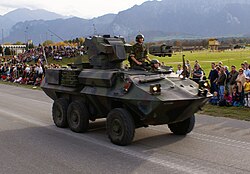
| |
| M-462 Abir Nimrod Anti-aircraft system | 500 | In Service | 
| |
| Nimrod Anti-aircraft system | 40 | In Service | 
| |
| Anti-aircraft batteries Eagle Eye | 120 | In Service | 
| |
| Oerlikon dual gun system | 75 | In Reserve | 
| |
| Bofors M1 | 150 | In Reserve | 
| |
| M8/M-55 AAA | 75 | In Reserve | 
| |
| FIM-92 Stinger | 60 | In Service |  | |
| MBDA Mistral | In Service | 
| ||
Weapons
Aircraft
| Fixed Wing | Origin | Type | Version(s) | In service[51] | Notes |
|---|---|---|---|---|---|
| Gulfstream Turbo Commander | Transport | Commander 1000 | 2 | ||
| Beechcraft King Air | Transport | 90 200 350 |
4 | ||
| Beechcraft Super King Air | Electronic warfare | 200 350 |
4 | ||
| Convair 580 | Airliner | 1 | |||
| Cessna 208 Caravan | Utility | 5 | |||
| Aero Commander 500 | Utility | Rockwell 685 Commander | 2 | ||
| CASA C-212 Aviocar | Transport | 2 | |||
| Antonov An-32 | Transport | 2 |
| Helicopters | Origin | Type | Version(s) | In service[51] | Notes |
|---|---|---|---|---|---|
| UH-1 Iroquois UH-1N Twin Huey |
Utility helicopter | UH-1H UH-1N |
64 | 41 of the UH-1N Twin Hueys are retired Canadian Forces aircraft.[52] | |
| Mil Mi-17 | Transport helicopter | Mi-17 MD | 21 | One lost on 25 February 2013.[53] | |
| Sikorsky UH-60 Black Hawk | Transport/ Combat helicopter | UH-60L S-70i |
54 7[54] |
Including the 15 from Plan Colombia. One UH-60 lost on 22 February 2013.[55] All S-70i helicopters used by the Special Operations Aviation Battalion.[54] |
| Unmanned Aerial Vehicles | Origin | Type | Version(s) | In service | Notes |
|---|---|---|---|---|---|
| RQ-11 Raven | Reconnaissance | RQ-11B | Special Forces[56] |
See also
- Military of Colombia
- Lancero
- Ranger
- Military ranks of the Colombian Armed Forces
- Colombian military decorations
Notes
References
- ^ a b "The Military Balance." The International Institute for Strategic Studies, 2018, p. 397.
- ^ https://www.ejercito.mil.co/conozcanos/simbolos_grados_distintivos/nuestros_simbolos&download=Y
- ^ "Línea de Mando." Ejercito de Colombia, 2019, www.ejercito.mil.co/conozcanos/linea_mando.
- ^ "Misión y Visión." Ejercito de Colombia, 2019, www.ejercito.mil.co/conozcanos/mision_vision_362168.
- ^ Henao, Jesús María (1920). Historia de Colombia para la enseñanza secundaria. Bogotá: Librería Colombiana, C. Roldán & Tamayo, 1820. pp. 342–344.
- ^ Roca Maichel, Luis Eduardo (1998). Historia de los Uniformes Militares de Colombia 1810 - 1998. Colombia: Imprenta y Publicaciones de las Fuerzas Militares. p. 45. ISBN 958-96487-0-3.
- ^ Manager, Micrositios Content. "Independencia, la Gran Colombia y la República (1819–1903) -". Ejército Nacional de Colombia. Retrieved 2016-11-18.
- ^ Manager, Micrositios Content. "Independencia, la Gran Colombia y la República (1819–1903) -". Ejército Nacional de Colombia. Retrieved 2016-11-18.
- ^ Bushnell, David (1993). The Making of Modern Colombia: A Nation in Spite of Itself. United States of America: University of California Press. pp. 157. ISBN 0520082893.
- ^ Manager, Micrositios Content. "Inicios del Siglo XX - Escuela Militar, Conflictos y Guerras Mundiales -". Ejército Nacional de Colombia. Retrieved 2016-11-18.
- ^ Manager, Micrositios Content. "Inicios del Siglo XX - Escuela Militar, Conflictos y Guerras Mundiales -". Ejército Nacional de Colombia. Archived from the original on 2017-08-20. Retrieved 2016-11-18.
- ^ Historia, Credencial. "Las guerras con el Perú | banrepcultural.org". www.banrepcultural.org. Retrieved 2016-11-18.
- ^ "Combate de Güepí | banrepcultural.org". 2014-11-29. Archived from the original on 2014-11-29. Retrieved 2016-11-18.
{{cite web}}: CS1 maint: bot: original URL status unknown (link) - ^ jwh1975 (2016-03-07). "The stahlhelm in Latin America after WWII". wwiiafterwwii. Retrieved 2016-11-18.
{{cite web}}: CS1 maint: numeric names: authors list (link) - ^ "Inicios del Siglo XX - Escuela Militar, Conflictos y Guerras Mundiales". National Army of Colombia. Archived from the original on 2017-08-20. Retrieved 2016-11-19.
- ^ "'Plan Colombia': How Washington learned to love Latin American intervention again". Washington Post. Retrieved 2016-11-18.
- ^ "La vedette de 'Operación Jaque' - Archivo Digital de Noticias de Colombia y el Mundo desde 1.990 - eltiempo.com". eltiempo.com. Retrieved 2016-11-18.
- ^ Padgett, Tim (2008-07-02). "Colombia's Stunning Hostage Rescue". Time. ISSN 0040-781X. Retrieved 2016-11-18.
- ^ Paris Match, no. 2964, March 9–15, 2006. Archived September 28, 2007, at the Wayback Machine
- ^ Coleman, Bradley Lynn (October 2005). "The Colombian Army in Korea, 1950–1954" (PDF). The Journal of Military History. 69 (4). Project Muse (Society for Military History): 1137–1177. doi:10.1353/jmh.2005.0215. ISSN 0899-3718.
- ^ Ruíz Novoa, Alberto [in French] (1956). El Batallón Colombia en Corea, 1951–1954. Bogotá: Imprenta Nacional. pp. 149–160. OCLC 1862975.
- ^ https://www.un.org/Depts/dpko/dpko/co_mission/unef1facts.html
- ^ Manager, Micrositios Content. "Fuerza de Despliegue Rápido - FUDRA - Ejercito Nacional de Colombia". Ejército Nacional de Colombia. Retrieved 2016-11-19.
- ^ "Cumple 10 años la Fudra, unidad élite del Ejército - Archivo Digital de Noticias de Colombia y el Mundo desde 1.990 - eltiempo.com". eltiempo.com. Retrieved 2016-11-19.
- ^ Manager, Micrositios Content. "Misión - DIVISION DE AVIACION ASALTO AEREO". Ejército Nacional de Colombia. Retrieved 2016-11-19.
- ^ "Aniversario 18 de la División de Aviación Asalto Aéreo del Ejército". www.webinfomil.com. Retrieved 2016-11-19.
- ^ https://www.shephardmedia.com/news/special-operations/colombian-army-activates-new-special-forces-battal/
- ^ "::SP NOTICIAS - Presidencia de la República de Colombia::". 2011-12-17. Archived from the original on 2011-12-17. Retrieved 2016-11-18.
{{cite web}}: CS1 maint: bot: original URL status unknown (link) - ^ Congreso de la República de Colombia (28 July 2010). "Ley 1405 de 2010 Nuevos Grados Militares" (in Spanish). Archived from the original on 2011-07-24. Retrieved 26 April 2011.
- ^ Ejército de Colombia (15 March 2011). "Grados y distintivos del Ejército" (in Spanish). Retrieved 26 April 2011.
- ^ a b "Capítulo V: Insignias militares". RGE 4-20.1: Reglamento de Uniformes, Insignias y Distinciones (in Spanish) (7th ed.). Colombia: National Army of Colombia. pp. 301–331. Retrieved 28 May 2021.
- ^ http://lcweb2.loc.gov/cgi-bin/query/r?frd/cstdy:@field%28DOCID+co0153%29
- ^ Colombia; Armored vehicles procurement programs summary Archived 2015-05-09 at the Wayback Machine – Dmilt.com, 3 January 2014
- ^ Colombian Army Acquires 28 Additional ASV Armored Personnel Carriers – Deagel.com, 22 August 2013
- ^ Colombia selects the Oshkosh Sandcat – Armyrecognition.com, December 20, 2012
- ^ El Ejército de Colombia adquiere un nuevo Hunter TR-12 para el Departamento de Huila – Infodefensa.com, 17 July 2013
- ^ "INDUMIL – Industria Militar". Retrieved 25 October 2014.
- ^ "IWI Galil ACE 5.56 mm assault rifle (Israel), Rifles". Jane's Information Group. Archived from the original on August 17, 2010. Retrieved August 17, 2010.
- ^ "Partes de guerra – FARC-EP Bloque Martín Caballero". Archived from the original on 3 June 2013. Retrieved 25 October 2014.
- ^ IMI Tavor. Unffmm.com. Retrieved on 2010-08-31. Archived July 17, 2011, at the Wayback Machine[better source needed]
- ^ "IWI Galil ACE 5.56 mm assault rifle (Israel), Rifles". Jane's Information Group. Archived from the original on 17 September 2012. Retrieved 17 August 2010.
{{cite web}}: CS1 maint: unfit URL (link) - ^ Daniel Watters. "The 5.56 X 45mm: 2008". The Gun Zone. Archived from the original on 2010-01-04. Retrieved 2009-01-27.
- ^ Cite error: The named reference
FBwas invoked but never defined (see the help page). - ^ Daniel Watters. "The 5.56 X 45mm: 2006". Gun Zone. Archived from the original on 2011-03-01. Retrieved 2009-05-23.
- ^ "Colombia Special Forces using Remington MSR -". The Firearm Blog. 8 June 2012. Retrieved 17 March 2020.
- ^ "Milkor MGL-140 Multi-Range Grenade Launcher (MRGL) (2008)". Military Factory. 15 June 2015. Retrieved 5 September 2015.
- ^ "Grenade Launcher MGL" (in Spanish). Indumil. Archived from the original on 7 July 2011. Retrieved 9 February 2012.
- ^ Cite error: The named reference
SIPRIwas invoked but never defined (see the help page). - ^ "Fuerza Aérea Colombiana presenta su nuevo helicóptero de ataque Arpía IV". Webinfomil.com. Retrieved 2017-03-24.
- ^ "Rafael sharpens Spike missile offering". Flightglobal.com. Retrieved 2017-03-24.
- ^ a b World Air Forces 2013 - Flightglobal.com, pg 13, December 11, 2012
- ^ http://www.rwrwalker.ca/CF_twin_huey.html
- ^ Air Forces Monthly. Stamford, Lincolnshire, England: Key Publishing Ltd. April 2013. p. 31.
- ^ a b Colombian Army receives two new S-70i helicopters - Janes.com, 4 September 2013
- ^ Air Forces Monthly. Stamford, Lincolnshire, England: Key Publishing Ltd. April 2013. p. 30.
- ^ Colombia; US donates ScanEagle UAV's to FAC Archived 2014-01-04 at the Wayback Machine – Dmilt.com, March 19, 2013

